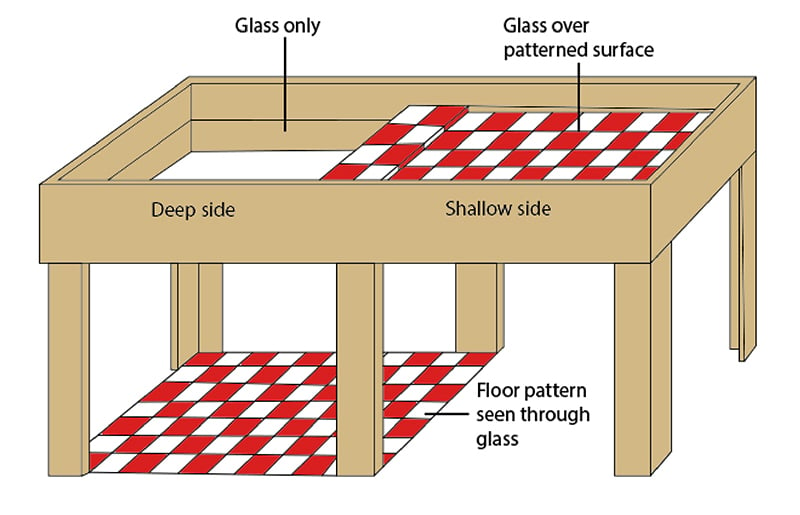On This Page:
Gibson, E. J., & Walk, R. D. (1960). The” visual cliff”. Scientific American, 202 (4), 64-71.

Aim
Eleanor J. Gibson and Richard D. Walk (1960) investigated the ability of newborn animals and human infants to detect depth.
Gibson and Walk tested whether youngsters would crawl over an apparent cliff – if the neonates did it could be assumed that the ability to see depth was not inborn.
If they did not, this would support a nativist view – that perceptual abilities are innate.
Procedure
Their apparatus consisted of a “bridge” on either side which was a sturdy glass platform. One side of this had a chequered pattern immediately under the glass (the “shallow side”). On the other side of the bridge was a “cliff” – the chequered pattern was beneath a vertical drop.
Experiment 1
Sample: 36 infants ranging in age from six months to 14 months. Their mother also participated in the experiment.
The independent variable (IV) was whether the infant was called by its mother from the cliff side or the shallow side (of the visual cliff apparatus).
The dependent variable (DV) was whether or not the child would crawl to its mother.
This was a repeated measures design because the infant was called from both the cliff side and the shallow side of the apparatus.
Experiment 2
Using the same apparatus, Gibson and Walk tested chicks, lambs, and kids (young goats), all less than 24 hours old.
The studies using other species are quasi (laboratory) experiments. The naturally occurring independent variable (IV) was the animal species, e.g., rat/chick/lamb/kitten.
The dependent variable (DV) was whether the animal preferred the shallow side or the deep side of the visual cliff apparatus.
They also used an adjustable floor on the deep side of the cliff so that the test could start with it in the high (and therefore safe) position but could be suddenly lowered once the animal was on it. This gave them the opportunity to observe the animal’s response and to see whether it learned from the experience of not “falling downwards.”
Other species were also tested, including rats (which were additionally tested with a raised bridge) and kittens, which were several weeks old before they could be tested. Some kittens were tested after being reared in the dark.
The rats were also tested with apparatus providing fewer visual cues by replacing the chequered pattern with a uniform grey surface to see whether the pattern was essential to perceiving depth.
Findings
- Gibson and Walk found that, even when encouraged to do so by their mothers, 92% of the babies refused to cross the cliff – even if they patted the glass.
- No chick, lamb, or kid crossed to the deep side. When the deep side was suddenly lowered, the animals froze into a defensive position. Even with repeated experience with this procedure, the animals did not learn that it was safe to stand on the glass.
- The rats used their whiskers to feel the glass so they would walk across to the deep side unless the bridge was raised so they couldn’t reach it with their whiskers.
- The kittens, like the other species, showed a marked preference for the shallow side. When reared in the dark until 27 days, however, this difference was not apparent and they crawled or fell as often onto the deep as the shallow side, neither did they show the typical freezing response when placed directly onto the deep side.
- However, after a week in the light, their behavior was just like that of light-reared kittens.
Conclusion
As the infants were able to detect the danger from the “cliff” side, Gibson and Walk concluded that their depth perception might be innate – it was at least present as soon as they could crawl.
However, as human infants take several months to crawl, it is possible that they had learned their ability to perceive depth during this time. The second experiment aimed to explore this possibility using animals.
Animals are able to judge depth as soon as they are mobile, whether that is immediately after birth/hatching or somewhat later. Although this is dependent on visual experience (i.e., being kept in the light), the time taken to recover from this deprivation is very short compared to the length of deprivation.
Together, the findings suggest that depth perception is an innate process.
The survival of any species requires that its members develop depth discrimination by the time they take up independent locomotion, whether this be in one day (the chick and the goat), three to four weeks (the rat and the cat), or six to 10 months (the human infant).
Critical Evaluation
The procedure was a rigorously controlled laboratory test, so it offered a reliable – but also safe – measure of depth perception. As it was possible to eliminate or control the influences of other senses (such as touch from the rats” whiskers), they ensured it was a valid test of visual perception.
The consistency of the results over a range of species, including humans, adds credibility to the findings. However, the sample of human infants was quite small, and the age range rather large – some were likely to have been crawling for some time before they were tested.
Although the mothers were present and gave informed consent, there was still a potential ethical issue. Simply looking at the drop, or being encouraged to cross it by their mothers, may have distressed the babies – they didn’t know the glass was there to save them.
The investigation of the nature-nurture issue in perception didn’t end with Gibson and Walk’s research. This only explored the plasticity of infant perception, so the question of whether adult perception could adapt was not considered.
This has, however, been investigated in several different ways. Stratton (1897) and Kohler (1962) used complex optical apparatus to change their view of the world, e.g., by inverting it using prisms.
In these situations, the world at first seems upside down or muddled, but over time the brain adapts to the change, and normal perception returns.
When the apparatus is removed, it again takes time to revert. Other, less dramatic changes to perception can be induced by shifting the field of view slightly to one side and then testing depth perception, e.g., by the ability to point accurately to a target.
In such situations, people adapt readily – within about an hour – but only if they are able to actively interact with their environment. Participants who are pushed around in wheelchairs fail to learn to cope with the visual distortion (held 7 Bossom, 1961). Findings such as these tell us that, at least in some respects, depth perception is learned.
References
Gibson, E. J., & Walk, R. D. (1960). The “visual cliff.” Scientific American, 202 (4), 64-71.
Kohler, I. (1962). Experiments with goggles. Scientific American, 206 (5), 62-73.
Stratton, G. M. (1897). Vision without inversion of the retinal image. Psychological Review, 4 (4), 341.

